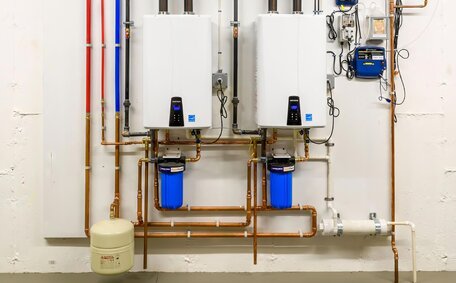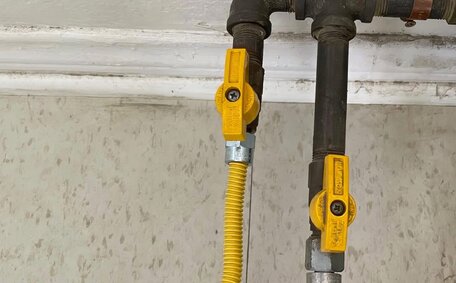
How Hard Water Hurts Hot Water Heaters
Hard water leaves mineral deposits in heaters, pipes and tanks. This limescale reduces efficiency, lifespan and hot water availability. Contact us for affordable water softening solutions.
Read MoreSafety relief valves are essential in maintaining the integrity of hot water systems. These valves also offer your water heater’s pressure relief, serving as a protective measure against excessive internal heat and pressure buildup. Temperature relief valves specifically help regulate pressure inside the tank by allowing hot water or steam to escape once predetermined temperature and pressure thresholds are exceeded.
A fully functional pressure relief valve is crucial for ensuring heater pressure relief and preventing system failures or hazards such as explosions. They provide an invaluable temperature relief mechanism that prevents water steam pressure from continuing to rise to dangerous levels. TPR valves give homeowners peace of mind knowing their system is equipped with this vital safety precaution.
This article explains how to manage water pressure and demonstrates how TPR valves ensure the safe operation of your water heater tank. We’ll explore valve components, pressure relief principles, testing procedures, and steps to take if your valve is faulty or leaking.
Temperature pressure relief (TPR) valves are critical safety devices found on gas hot water tanks. They serve a critical function - monitoring water temperature and pressure inside the gas hot water tank and regulating these levels to prevent hazardous buildups.
Typically, temperature pressure relief valves automatically activate when water system temperature or pressure exceeds safety limits. Most TPR valves are calibrated to open when temperatures reach 210°F or when pressure exceeds 150 psi.
By releasing excess hot water or steam, TPR valves make sure your system’s pressure temperature is relieved. This prevents potential explosions or other dangerous system failures from occurring due to unchecked pressure/temperature increases.
TPR valves maintain constant vigilance over temperature and pressure, enhancing your home’s safety by ensuring water heaters operate within secure limits. They are a vital component in regulating hot water systems and ensuring your home’s safety.
Temperature relief valves operate by automatically triggering when unsafe levels are detected inside the hot water system. This key safety function prevents hazardous buildups and protects the heater from damage.
Specifically, TPR valves contain a spring-loaded release valve disc that helps maintain closure. This disc presses up against an o-ring seal to keep the valve closed during normal operation. However, when temperatures climb above 210°F or pressure exceeds 150 psi, the disc unseats from the o-ring and opens the valve.
When open, the TPR valve addresses hot water steam expansion by releasing a discharge through a drain line, relieving mounting pressure inside the system. As pressure is reduced during the heating cycle, the valve will eventually close again on its own. This cycle repeats as needed to regulate excessive temperatures or pressures.
TPR valves automatically modulate to maintain pressure, serving as an essential component in pressure regulation. They are fundamental to hot water system safety and should be well-maintained to ensure proper operation when required.
You can usually find TPR valves positioned near the top of the water heater tank. Most models have the TPR valve mounted on the water tank around 4-6 inches down from the very top of the unit.
Positioning the open water heater TPR valve higher up enables it to detect and respond to excessive temperatures or pressures inside the tank more readily. The valves are strategically installed on the hot water tank to offer rapid pressure relief when thresholds are exceeded.
TPR valves are also connected to a discharge pipe that redirects released steam/hot water safely down to drain. This discharge tube runs from the TPR valve outlet down the side of the tank, terminating just above the down drain valve bottom.
This setup ensures high-temperature discharges are directed safely through the drain line, minimising the risk of scalding surrounding areas. It also enables the TPR valve to function properly each time pressures call for opening.
One of the most serious potential hazards is if a valve can introduce the risk of dangerous explosions associated with gas water systems. However, properly installed and well-maintained heater pressure relief valves play a pivotal role in preventing these catastrophic failures.
The heater pressure relief valve TPR mechanism releases excess before it can escalate to danger levels capable of causing system damage and endangering the occupants. By automatically opening and discharging water/steam when unsafe water heater pressure relief thresholds inside the tank are exceeded, TPR valves mitigate the risk factors that can lead to blasts.
Testing the TPR valve involves regular checks and, if needed, replacing faulty valves to ensure the system remains safely pressurised. Letting small problems go can allow pressures to creep past safety limits over time, setting the stage for hazardous explosions.
Although properly equipped water heaters rarely explode, failure to maintain and test TPR valves can increase this risk. Test your system and shield your family by ensuring the TPR valve is in excellent working order at all times.
To ensure TPR valves remain operational, regular hot water system service and testing are necessary. Industry standards recommend testing TPR valves at least once every 6 months to ensure they’re working correctly.
Testing involves manually operating the TPR valve to verify that it’s working effectively, opens and closes properly, and that the discharge pipe is clear of obstructions in your valve system. Here is a simple process to follow:
Besides testing for correct operation, inspect valves annually for leaks, corrosion, and other issues that may affect electric hot water systems. Replace any valve that’s been in service for every five years.
While testing TPR valves is relatively quick and straightforward, replacement due to age or failure requires a licensed plumber to ensure the system remains up to code and functioning safely after repairs.
Industry standards recommend testing TPR valves at least every 6 months to ensure they function properly. More frequent testing may be advised in certain situations.
The procedure for maintaining a hot water heater involves testing TPR valves with the following steps:
It’s ideal to inspect TPR valves twice a year, including checks during cold water flow, to validate their functionality. However, more frequent monthly checks are recommended if valves are older, subject to frequent cycling, or ever fail the standard tests.
Should testing or inspection reveal problems with your TPR valve, replacement is necessary. Common signs of a faulty TPR valve include: constant dripping or valve leak, failure to open and release water when tested, the valve stuck shut, blockage in the discharge pipe, and significant corrosion or damage.
Replacing a defective TPR valve involves the following general steps:
Only copper or CPVC pipes are approved materials for TPR valve discharge lines. Ensure you adhere to all local codes in your area and standards when selecting and installing replacement valves and piping.
Although an experienced DIY enthusiast might tackle replacing a faulty TPR valve, exercise caution when draining hot water tanks to prevent injuries. Calling in professional plumbers ensures the repair is handled properly.
Over time, TPR valves may encounter issues that compromise their safety functions. Being aware of these potential issues and addressing them promptly is key to keeping your hot water system operating safely.
Some of the most common TPR valve problems include:
Catching and addressing TPR valve problems quickly avoids preventable hazards. Annual inspections paired with 6-month functionality testing helps mitigate risks. Reach out to plumbers if you suspect issues exist with your TPR valve.
Despite the reliability of TPR valves as safety devices, leaks may indicate potential failure from wear and tear, mineral buildup, corrosion, or damage. That’s why it’s critical to have your licenced plumber thoroughly inspect, test and if necessary, replace your TPR valve on a regular basis.
Replacing TPR valves requires completely draining the hot water system, which involves hazards like exposure to scalding water and heavy equipment. Trying to replace valves yourself risks installing incompatible components or incorrectly rated valves that compromise safety. Always defer TPR valve replacements to qualified professionals.
Our licenced plumbers have extensive training and experience servicing all makes and models of hot water systems. We follow manufacturer specifications and plumbing codes to ensure new TPR valves are precision-matched to safety your system’s requirements.
Make sure to trust us to get the job done right, keeping your water heater working safely for years to come.
Contact our team for expert TPR valve inspection, testing, or replacement at 1300 349 338 or email jobs@picnicpointplumbingservices.com.au. We also offer maintenance plans and warranties on parts/labour for peace of mind.
Hard water leaves mineral deposits in heaters, pipes and tanks. This limescale reduces efficiency, lifespan and hot water availability. Contact us for affordable water softening solutions.
Read MoreIt’s important to routinely check your gas appliances for any issues. Signs of problems include gas leaks, strange sounds, odd smells and more. Have a professional inspect your gas appliances annually and service them regularly for safety.
Read MoreUpgrading your gas meter is a simple process completed by registered technicians. It involves disconnecting your gas supply for 15 minutes to swap the old meter for a new digital smart meter. The upgrade is free and improves accuracy.
Read MorePicnic Point, 2213 NSW
We will call back as soon as possible.




